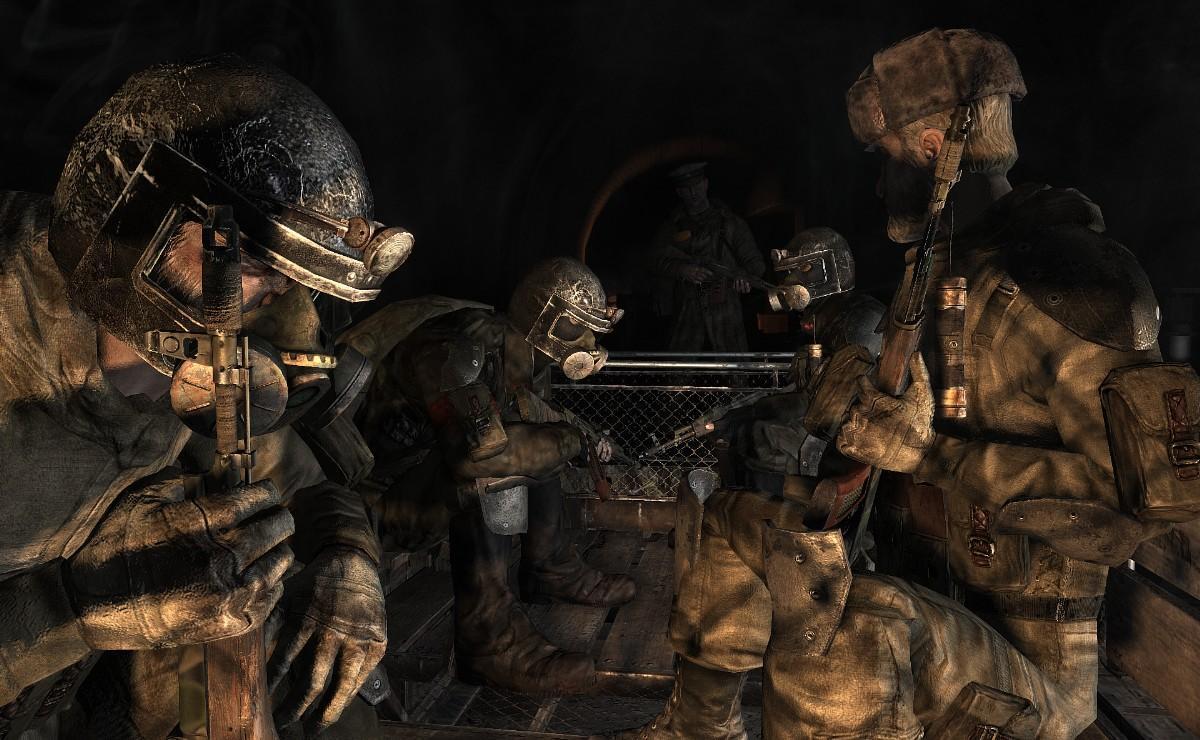Innovative touches mark this title out from the crowd, but a difficulty imbalance mars what is otherwise an enjoyable single-player experience.
As advances in console processing power have seen the graphical gap between platforms almost disappear, the strengths of a game are most often to be found in what new things it brings to its genre’s table.
When a current-generation FPS goes down the linear route, it’s often seen as a shortcoming and by console gamers in particular. PC gamers who consider themselves FPS players are hardened to accept a great deal of the Doom blueprint: shoot, get key, shoot, use key, shoot. This is a well-tested design philosophy but, by comparison, console ports of these games have not enjoyed the same kind of stoic acceptance as their PC counterparts. How, then, does a modern, cross-platform shooter like Metro 2033 stand out from its peers?New Kid on the Bloc4A-Games’ March release Metro 2033 plants its flag firmly in linear territory, eschewing the branching plot of Fallout 3 and the sense of adventure felt in Just Cause or Crysis. Whether this is to its detriment or benefit depends on where the player sees themselves as fitting into a plot.
When an apocalyptic event ravages Russia, around 40,000 people take shelter in Moscow’s largely bomb-proof system of metro tunnels. Over the next 20 or so years, radiation causes mutations in the surviving wildlife and the subterranean Muscovites find themselves on the brink of extinction. The player character, Artyom, is tasked to leave his station and embark on a quest to save the tunnel dwellers’ way of life.
Looking at what Metro 2033 brings to the top table, I think what first struck me is its sophisticated phantom inventory system — phantom as an item’s use is often toggle-only. A gas mask and repeated filter changes add a sense of urgency to outdoor sections, and a failing torch with wind-up dynamo forces the player to multitask while under some stress. These and other mechanical elements prompt pauses, regrouping, and the player to take stock on a regular basis.
A cynic might say that these punctuatory stops add to the game’s length and the mask’s limited oxygen supply stops the player from exploring much of Moscow’s ruins, but I’d say the plot pacing they provide are a fair trade.
Where levelled single-player games often fall down is in their loading times between each section, and Metro 2033 does have noticeable pauses. However, this is very neatly abridged by a small amount of text, accompanied by Artyom’s thickly accented voice. It feels like the beginning of a chapter from a book, much as the game is an adaptation of a popular Russian novel of the same name.
The levels, when they do begin, can vary in length and most definitely in difficulty. I found several to be overlong, and with too many enemies, or an uneven number: I counted 40 beaten enemies on one level and six on another. The animations for adversaries often seem to miss a few frames. This is most noticeable in the attacks of the “devil dogs”, which also focus on the player’s feet, making it impossible to keep tabs on where they are after their lunge.
The weapon trading system gives an element of re-playability to the game, as I reckon it would be very hard to buy all the weapons on one run-through. The bartering units of the Metro underground are military-grade bullets, which are of a much better standard than rounds made by survivors. I found the amount of better quality ammunition to be very sparse on medium difficulty, so upgrading to the best example of a gun type was an infrequent occurrence.
The inventory pacing mechanic is also applied to your armoury in the form of pneumatic weapons, where pressure is applied to arrows and pellets to create some of the game’s most devastating ordnance. Pumping the “Van Helsing” crossbow several times before silently taking an enemy down is one of Metro 2033’s high points.Warsaw im-pactWere there to be any cultural resonance of a Russian game imparted to the shooter genre, one of the easiest ways in which this could be judged is by listening to it. I was surprised by the rarity of generic “Steppe” music one would assume to be present, instead replaced by sombre, atmospheric acoustic guitar. The understatement of the soundtrack and ambient noise is comparable to Diablo, and is similar in its effortless ease in creating and diffusing tension.
Perhaps the most satisfying encounters the player character has with his fellow tunnel dwellers are in the crowded marketplaces which are the hubs of most settlements he visits. It’s only possible to discern snatches of conversation, if any parts at all. A proper enjoyment of these scenes only comes with the realisation that entire stories aren’t intended to be told, and that’s when the hubbub really brings the characters to life.
If Metro 2033’s colour palette looks familiar to fans of GSC Game World’s series of Stalker games, this is no coincidence as parts of the game team worked on that franchise, whose promise I feel outstrips what has been made of it so far. There are commonalities in the textures and atmosphere of both games, although I would say this is a tribute to the work of texture artists in sourcing their materials. Metro 2033 will not win any awards for its graphics, but I like how solid the experience is and would liken it to Gears of War in its mongrel earthiness.
My one audio/visual gripe is the absence of a Russian language option with English subtitles. While the accents seem (mostly) authentic, there are patches where the suspension of disbelief is hard to maintain. A Russian audio track would have given the game extra authenticity: it’s crying out for a little more niche appeal.
Stronger — Arx Fatalis (2002)
Weaker — Stalker: Call of Pripyat (2010)
